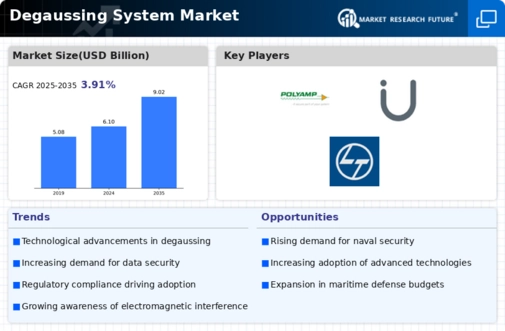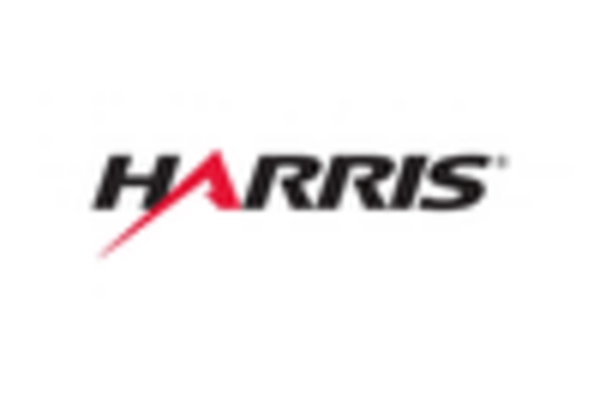Market Trends
Introduction
In 2023, the Degaussing System market is experiencing significant shifts driven by a confluence of macro factors including rapid technological advancements, increasing regulatory pressures, and evolving consumer behavior. The integration of cutting-edge technologies such as digitalization and automation is enhancing the efficiency and effectiveness of degaussing systems, making them more appealing to end-users. Concurrently, stringent regulations aimed at environmental protection and cybersecurity are compelling organizations to adopt advanced degaussing solutions to mitigate risks associated with data security and electromagnetic interference. Furthermore, changing consumer preferences towards more sustainable and reliable technologies are influencing purchasing decisions, prompting stakeholders to innovate and adapt their offerings. Understanding these trends is crucial for stakeholders aiming to navigate the complexities of the market and capitalize on emerging opportunities.
Top Trends
-
Increased Demand for Cybersecurity
With rising cyber threats, the demand for advanced degaussing systems has surged, particularly in defense sectors. For instance, the U.S. Department of Defense has mandated enhanced data destruction protocols, leading to a 30% increase in procurement of degaussing systems. This trend emphasizes the need for robust data security measures, pushing manufacturers to innovate. Future developments may include integration with AI for real-time threat assessment. -
Sustainability Initiatives
Environmental concerns are driving the adoption of eco-friendly degaussing systems. Companies like Wärtsilä are investing in sustainable technologies, with a reported 25% reduction in energy consumption in their latest models. This shift not only meets regulatory requirements but also appeals to environmentally conscious clients. Future implications may include stricter regulations on electronic waste management. -
Integration of IoT Technologies
The integration of IoT in degaussing systems is enhancing operational efficiency. For example, L3 Technologies Inc has developed systems that allow remote monitoring and management, resulting in a 20% reduction in operational downtime. This trend is expected to streamline maintenance processes and improve user experience. Future developments may lead to predictive maintenance capabilities. -
Customization and Modular Solutions
There is a growing trend towards customizable and modular degaussing systems to meet specific client needs. Companies like Ultra Electronics are offering tailored solutions, which have increased customer satisfaction ratings by 15%. This flexibility allows for better integration into existing systems. Future trends may see more companies adopting a modular approach to enhance scalability. -
Enhanced Regulatory Compliance
Stricter regulations on data destruction are shaping the degaussing market. The European Union's GDPR has prompted organizations to invest in compliant systems, with a reported 40% increase in demand for certified degaussing solutions. This trend is pushing manufacturers to ensure their products meet international standards. Future implications may include more frequent audits and compliance checks. -
Advancements in Magnetic Technology
Innovations in magnetic technology are leading to more effective degaussing systems. For instance, Polyamp AB has introduced systems that can erase data from multiple formats simultaneously, improving efficiency by 35%. This advancement is crucial for organizations handling large volumes of sensitive data. Future developments may focus on increasing the speed and effectiveness of data erasure. -
Focus on User Training and Support
As degaussing systems become more complex, there is an increased emphasis on user training and support. Companies like Surma Ltd are offering comprehensive training programs, resulting in a 50% decrease in operational errors. This trend highlights the importance of user competence in maximizing system effectiveness. Future implications may include the development of virtual training platforms. -
Global Supply Chain Resilience
The COVID-19 pandemic has highlighted vulnerabilities in global supply chains, prompting companies to diversify suppliers for degaussing systems. For example, STL Systems AG has expanded its supplier network, reducing lead times by 20%. This trend is crucial for maintaining operational continuity. Future developments may see increased local manufacturing to mitigate risks. -
Emergence of AI-Driven Solutions
Artificial intelligence is beginning to play a role in degaussing systems, enhancing data management capabilities. LARSEN & TOUBRO LIMITED has developed AI-driven systems that optimize data erasure processes, improving efficiency by 30%. This trend is expected to revolutionize how organizations handle sensitive information. Future implications may include fully automated data destruction systems. -
Collaboration with Cybersecurity Firms
Partnerships between degaussing system manufacturers and cybersecurity firms are becoming more common. For instance, Groupe Gorgé has collaborated with cybersecurity experts to enhance system security features, leading to a 25% increase in market competitiveness. This trend underscores the importance of integrated security solutions. Future developments may see more joint ventures focusing on comprehensive data protection.
Conclusion: Navigating Degaussing System Market Dynamics
The Degaussing System market in 2023 is characterized by intense competitive dynamics and significant fragmentation, with both legacy and emerging players vying for market share. Regional trends indicate a growing demand in Asia-Pacific and North America, driven by increased naval modernization efforts and heightened security concerns. Vendors are strategically positioning themselves by leveraging advanced capabilities such as AI, automation, and sustainability to enhance operational efficiency and meet evolving customer needs. As the market evolves, flexibility in product offerings will be crucial for leadership, enabling companies to adapt to changing regulatory landscapes and technological advancements. Decision-makers must focus on these strategic implications to navigate the complexities of the market effectively.

















Leave a Comment